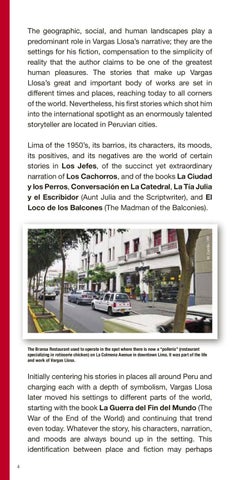The geographic, social, and human landscapes play a predominant role in Vargas Llosa’s narrative; they are the settings for his fiction, compensation to the simplicity of reality that the author claims to be one of the greatest human pleasures. The stories that make up Vargas Llosa’s great and important body of works are set in different times and places, reaching today to all corners of the world. Nevertheless, his first stories which shot him into the international spotlight as an enormously talented storyteller are located in Peruvian cities.
M. Carrillo / PP
Lima of the 1950’s, its barrios, its characters, its moods, its positives, and its negatives are the world of certain stories in Los Jefes, of the succinct yet extraordinary narration of Los Cachorros, and of the books La Ciudad y los Perros, Conversación en La Catedral, La Tía Julia y el Escribidor (Aunt Julia and the Scriptwriter), and El Loco de los Balcones (The Madman of the Balconies).
The Bransa Restaurant used to operate in the spot where there is now a “pollería” (restaurant specializing in rotisserie chicken) on La Colmena Avenue in downtown Lima. It was part of the life and work of Vargas Llosa.
Initially centering his stories in places all around Peru and charging each with a depth of symbolism, Vargas Llosa later moved his settings to different parts of the world, starting with the book La Guerra del Fin del Mundo (The War of the End of the World) and continuing that trend even today. Whatever the story, his characters, narration, and moods are always bound up in the setting. This identification between place and fiction may perhaps 4
